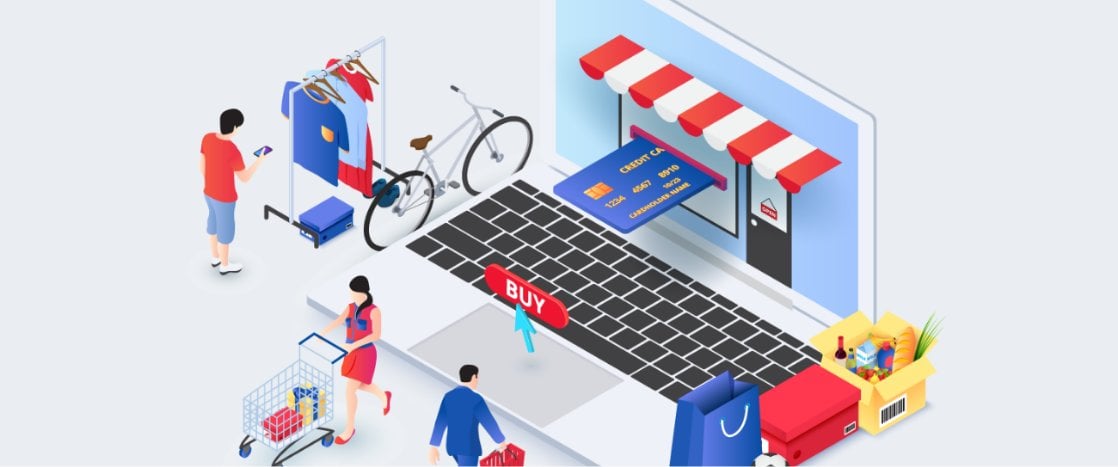By Tom Wintaugh | June 5, 2023

See why top ecommerce brands use Miva’s no-code platform to run
multiple stores, manage massive catalogs, and grow their revenue.
With ecommerce traffic on the rise more businesses will undoubtedly throw their hat in the ring to partake in growing annual ecommerce revenue. Amidst this competition, the primary way to leverage consumer attention is by creating a relevant and personalized experience for your visitors, period, full stop.
According to a recent survey by HubSpot, ecommerce traffic across categories continues to be robust, with B2B and B2C websites logging anywhere from 1,000 to 2 million+ unique monthly visitors in 2022. This totals up to an enormous 2.3 billion 2022 ecommerce buyers from across the spectrum, up from 2.1 billion in 2021. To take advantage of this traffic, it's imperative for online businesses to strategically optimize their shopping experiences to leap out to prospective buyers in an increasingly crowded marketplace. In this blog, we’ll look at key strategies for how to get your website noticed, including attracting traffic, and then transforming that attention into revenue.
Focusing on the quality of the experience must come before you invest in marketing to show your site to potential customers—here’s why: your online storefront is more than a digital catalog of products or services. It's a total shopping experience which can be strategically honed to appeal to specific segments of customers, and to provide satisfying experiences for those customers when they arrive at your site. Investing in increasing ecommerce traffic before you have your website experience dialed in is a waste of resources. Here are three central tenets of an appealing and effective shopping experience which will draw quality traffic to your business.
Personalization: Today's buyers don’t just appreciate a tailored experience—they require it. Shoppers expect your website to understand and accommodate their needs, preferences, and behaviors. This might involve recommending products based on browsing history, providing personalized content that resonates with their customer profile, or orienting buying processes to preferences and terms of their account. By harnessing data analytics, you can delve deeper into the reasons that shoppers choose to give you their their business, and then lean into serving those needs.
Streamlined Navigation and User Experience (UX): Think of your website as a guided tour for your prospective customers. If they don’t feel taken care of and can't find what they're looking for, they're likely to leave. A well-structured website, with easy navigation and quick loading pages, can keep your visitors engaged and encourage them to explore further. We wrote more about ecommerce UX here. And as we’ll discuss below, a well-organized site UI is also a key component of SEO that leads to quality traffic. Why? Google essentially sends people to websites which it thinks will give them the best customer experience. In this way, traffic and shopping experience are directly linked.
Robust Customer Support: In an era where digital interactions are increasingly automated, offering proactive and immediate customer support can be a game-changer. This could involve live chats, quick response to queries, or even chatbots that give assistance around the clock. Again, this is a feature can contribute to how to get your website noticed in the first place. Building a reputation (with shoppers and Google) for delivering very effective support is very attractive to future site visitors.
If your only goal was to draw ecommerce site traffic to your website, the effectiveness of your sales techniques wouldn’t matter. But as we see repeatedly, getting noticed in a sea of competitors must go hand-in-hand with providing effective shopping experiences for people who choose to visit your site. Increased sales and revenue are the ultimate goal for both...so, part of understanding website traffic involves looking at how effective you are at converting that attention into sales. Without the conversions, ecommerce traffic is relatively meaningless for a business. The real challenge is converting these visitors into leads, and eventually, customers. Here are three ways to look at traffic which emphasize how it leads to conversion.
1. Prioritize Quality Traffic Over Quantity:
While a high number of website visitors looks impressive on analytics reports, it's the quality of that traffic which truly impacts your bottom line. You need visitors who have a genuine interest and need for your offerings—those who are more likely to convert. Once you identify the profile or persona of your most promising customers, deploy targeted marketing and SEO strategies to attract this kind of high-intent traffic.
2. Optimize Every Part of Your Site for Better Conversion Rates (CRO):
Tweaking your website to maximize conversions can have a profound impact on your sales numbers and make website traffic far more lucrative. Even small adjustments to site organization, aesthetics, and speed can have an oversized impact on conversions. This might involve testing different website designs, streamlining the order and checkout process, or crafting compelling calls to action that encourage the visitor to make a purchase. We compiled a comprehensive guide to how to optimize websites for conversion here.
3. Retarget Site Visitors To Close More Sales:
Not every website visitor will convert during their first visit. This is where retargeting comes into play. Capture more long-tail sales and reconnect with your website visitors by using personalized email campaigns or retargeting ads. In this way, you can encourage more traffic from the users who are most likely to visit because they are already familiar with (and hopefully impressed by) your shopping experience. By reminding them of what they left behind or showcasing new offerings, you can nudge these visitors back to your site and closer to a purchase. We describe the perils of abandoned carts here.
Once you feel confident that your website is optimized for maximum effectiveness and appeal, it’s time to reach out to potential customers to let them know about your business and invite them to visit. Traffic-driving techniques, though common, need to be dialed in for specific audiences and channels as much as possible. Retail ecommerce and B2C companies primarily target individual consumers. Their products or services often appeal to emotions and personal needs, with shorter sales cycles and a higher volume of potential customers. Here are common strategies for B2C ecommerce traffic generation:
Search Engine Optimization (SEO): SEO is widely used as the primary tool for attracting site visitors to a business. People shopping online usually begin their journey with an organic search—in fact, 71% of all retail purchases begin with browser-based search. With consumers frequently using search engines for shopping, ranking highly on search results is obviously crucial. We wrote about the foundations of effective SEO for ecommerce sites here—if you aren’t currently optimizing your site for SEO, you are leaving a massive amount of potential purchases on the table.
Email Marketing: Despite the growth of social media, email remains a very effective channel for driving traffic. The key, of course, is developing a healthy and responsive email list. This might begin with newsletter signups, giveaways, or targeted advertising with the objective of email signups. B2C email campaigns often involve promotional offers, new product launches, and personalized product recommendations to inspire a user to click through to your site.
Social Media Marketing: B2C companies often use platforms like Facebook, Instagram, and TikTok to connect with potential customers. Regular posting of high quality, relevant, and entertaining content is a must, combined with sponsored ads and influencer partnerships to help reach a broad audience. This blog dives deeper into using social media for ecommerce marketing.
B2B companies target other businesses, and as a result, traffic-generating techniques often employ a more rational, needs-based approach. The B2B sales cycle is longer, purchases are larger, and while there may be fewer potential customers, each customer holds more value. With this in mind, here are the most effective strategies for B2B traffic generation:
Search Engine Optimization (SEO): Again, SEO tops the list of traffic drivers. SEO is equally important for B2B, but the focus is often on very industry-specific, very high-intent keywords. As these keywords generally have lower search volume, they can actually be easier to rank for vs more ubiquitous retail-oriented searches. The key is to specifically target keywords which will drive only the most highly qualified traffic to your site. This is what is meant by “quality traffic.”
Content Marketing: B2B customers often seek out valuable, industry-specific content. Regularly publishing high-quality blog posts, whitepapers, and case studies can attract traffic and position your company as a thought leader.
LinkedIn Marketing: LinkedIn is an important platform for B2B companies. Sharing insightful content, participating in discussions, and connecting with industry professionals on LinkedIn can definitely drive more site traffic.
Webinars and Events: Hosting webinars, live events, or participating in other companies’ industry events can position your business as a member of a specific commercial community, lending authority, generating interest, and driving traffic to your store.
As all forms of ecommerce continue to gain market share, sellers will have access to more prospective buyers than ever before, if they are prepared. Harnessing this wave requires more than just an ad spend—it calls for a strategically optimized ecommerce experience and a focus on the high-quality traffic which will gain the most from it. When these elements align, your business can capture a larger share of those 2.4 billion shoppers, and give them a shopping experience which makes them feel great about visiting your site.


Katy Ellquist, Miva’s Digital Marketing Strategist, is an accomplished writer, marketer, and social media analyst who has created sophisticated content campaigns for a broad range of professional clients. She brings to Miva a complex understanding of ecommerce trends and techniques, building upon extensive digital agency experience and a prior role as direct liaison to Miva’s top accounts. Katy is a regular contributor to the Miva blog, covering essential ecommerce topics like design & development strategy, site optimization, and omnichannel selling, with the goal of increasing the actionable knowledgebase of the entire Miva community.
Love it? Share it!
No worries, download the PDF version now and enjoy your reading later...
Download PDF